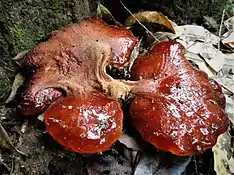Fistulina subhepatica
Fistulina subhepatica is a species of fungus in the family Fistulinaceae. It is found in Yunnan Province in subtropical China, where it causes brown rot on Castanopsis and Lithocarpus. It was described as new to science in 2014 by Bao-Kai Cui and Jie Song. It is named for its resemblance to the common beefsteak fungus, Fistulina hepatica, from which it can be distinguished by its larger spores (measuring 4–6 by 3–4.5 μm), and generative hyphae with clamp connections.[1]
| Fistulina subhepatica | |
|---|---|
 | |
| Fistulina subhepatica in Laos | |
| Scientific classification | |
| Kingdom: | |
| Division: | |
| Class: | |
| Order: | |
| Family: | |
| Genus: | |
| Species: | F. subhepatica |
| Binomial name | |
| Fistulina subhepatica B.K.Cui & J.Song (2014) | |
References
- Song J, Han ML, Cui BK (2015). "Fistulina subhepatica sp. nov. from China inferred from morphological and sequence analyses". Mycotaxon. 130 (1): 47–56. doi:10.5248/130.47.
This article is issued from Wikipedia. The text is licensed under Creative Commons - Attribution - Sharealike. Additional terms may apply for the media files.